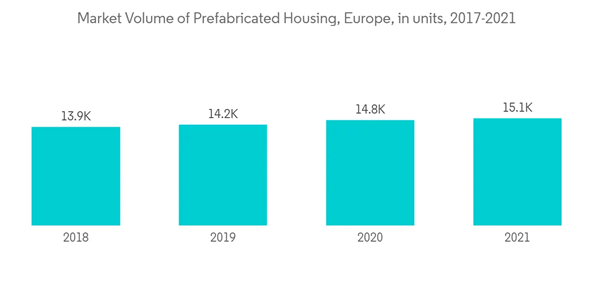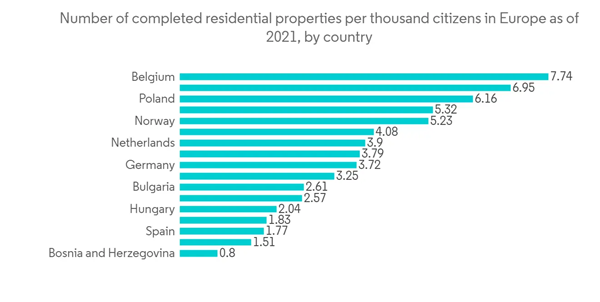Key Highlights
- The building and construction sector is facing challenging circumstances. The dynamics of growth throughout this time have been impacted by several factors, including project suspension, risk management, and insurance, personnel management, supply chain delays, the dispute resolution process, scheduling and adjustment, and contract notices for default. Manufactured homes are creative answers to the need for high-quality, reasonably priced housing. In a factory, the housing units are created and created. The manufactured home is transported and installed at the chosen location following project completion. In industrialized nations, energy efficiency and a smaller carbon footprint are major drivers of the manufactured house market's expansion.
- The COVID-19 pandemic outbreak has caused significant concern for suppliers and contractors across the European construction sector. Several construction companies had to shut down their projects because of the lockout and restrictions. The manufactured home market is anticipated to benefit greatly from the usage of additive manufacturing in Europe. Additionally, it is anticipated that the demand for prefabricated materials for home decoration would present sizable potential in the future, fueling market expansion throughout the projection period.
- Sweden has a high penetration rate and is one of the most developed markets in the world for prefabricated dwelling construction. Around 80% of Sweden's housing market is made up of prefabricated materials from factories, making it the world leader in the use of panelized building systems. Another significant element fueling market expansion in this region, particularly in Switzerland, Northern Europe, and the United Kingdom, is the advent of turnkey solutions. The market share for manufactured homes in Europe is dominated by Germany, Northern Europe, and the United Kingdom.
Europe Manufactured Homes Market Trends
Demand of Prefabricated Houses is Increasing in Sweden
- Sweden is widely regarded as a Global Exemplar of Offsite Manufacturing, leading the world in terms of The Sheer Number Of Panelised Single Dwelling Residences, which represent over 80% of the Country’s Overall Housing Market. The majority of factory-built wooden homes in Sweden are made of closed wall panels, and this trend is expected to continue as a result of current market pressures. Sweden has the largest percentage of prefab homes in the world.
- Prefab homes are very popular due to the significant construction boom that Sweden is currently experiencing and the additional pressure that skills shortages in traditional construction trades are putting on the industry. The abundance of slow-growing, premium-quality timber and the nation's very difficult climatic circumstances are among the many elements that have contributed to Sweden's domination of the offsite space in terms of skills, knowledge, and industry structure.
Sustainability and technological advancement
- Sweden is a pioneer in prefabricated construction, a method that can significantly reduce construction costs. Up to 84 per cent of detached homes in Sweden contain prefabricated components, compared to roughly 15 per cent in Japan and 5 per cent in the United States, the United Kingdom, and Australia. Off-site construction was invented in Sweden and has been made successful on a scale that few other countries have equalled by prefab and modular home builders there.
- Scandinavia's leading producer of modular homes is Lindbäcks Bygg. Its assembly lines have transformed the famously sluggish construction sector in its nation, and there is great potential for exporting that success elsewhere. The 75-year-old business will be able to construct more than 25,000 square feet of turnkey housing per week after a new plant goes online in 2021.
- Through the use of innovative automation, the company has been able to maintain its lead over the competition. Lindbäcks receives assembly line robotics from the Swedish construction technology company Randek, which transforms building construction into something more akin to automobile production. Lindbäcks has been able to streamline its production process and outperform its competitors by taking inspiration from Toyota's production strategy, which reduces waste and depends on its employees to offer ways to maximise efficiency.
Europe Manufactured Homes Industry Overview
The Europe Manufactured Homes Market is fragmented, but it is anticipated to expand over the course of the forecast period due to a rise in investments in prefab construction buildings, future significant projects in the nation, and a few other factors. Major players are Skanska AB, Peab AB, Swietelsky AG, Laing O'Rourke, and Bouygues Batiment International. The use of prefabricated building systems and construction has the potential to significantly increase the effectiveness and performance of the European construction sector in terms of sustainability. Environmentally friendly manufacturing processes and materials are being used by businesses to set their products apart from those of rivals.Additional Benefits:
- The market estimate (ME) sheet in Excel format
- 3 months of analyst support
This product will be delivered within 2 business days.
Table of Contents
Companies Mentioned (Partial List)
A selection of companies mentioned in this report includes, but is not limited to:
- Skanska AB
- Peab AB
- Swietelsky AG
- Laing O'Rourke
- Bouygues Batiment International
- Derome AB
- Wolf Holding GmbH
- DFH Group
- Containex
- Portakabin Ltd*










